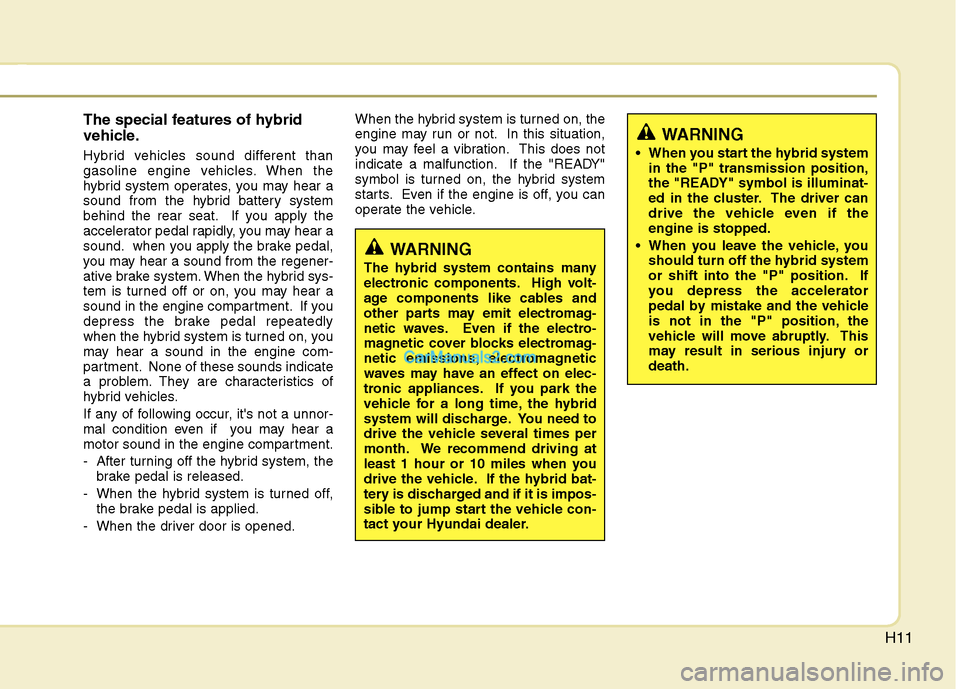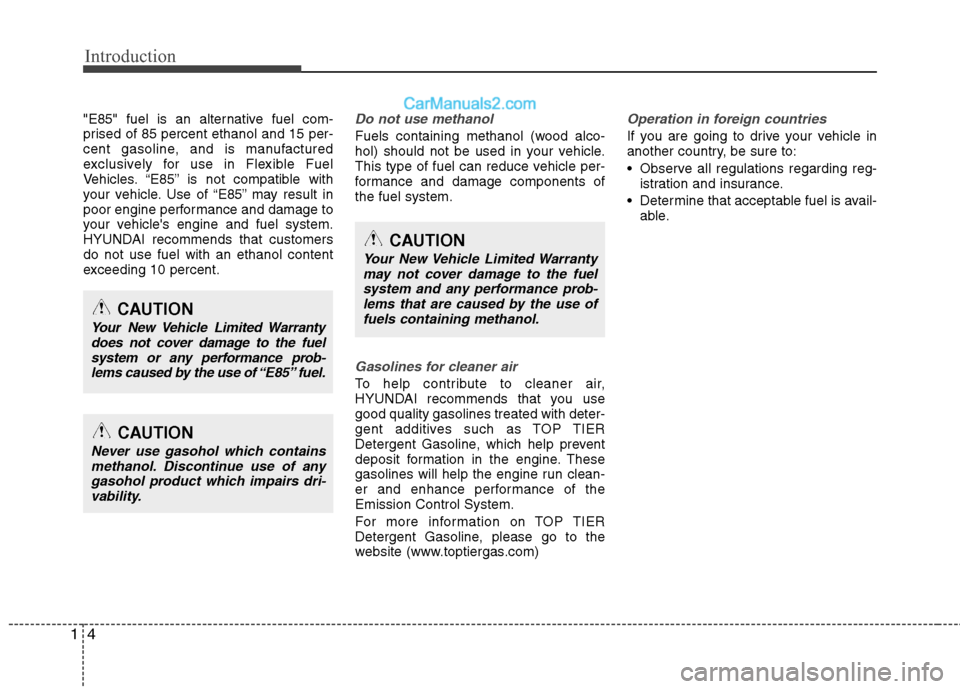Page 18 of 404

H11
The special features of hybrid
vehicle.
Hybrid vehicles sound different than
gasoline engine vehicles. When the
hybrid system operates, you may hear a
sound from the hybrid battery system
behind the rear seat. If you apply the
accelerator pedal rapidly, you may hear a
sound. when you apply the brake pedal,
you may hear a sound from the regener-
ative brake system. When the hybrid sys-
tem is turned off or on, you may hear a
sound in the engine compartment. If you
depress the brake pedal repeatedly
when the hybrid system is turned on, you
may hear a sound in the engine com-
partment. None of these sounds indicate
a problem. They are characteristics of
hybrid vehicles.
If any of following occur, it's not a unnor-
mal condition even if you may hear a
motor sound in the engine compartment.
- After turning off the hybrid system, the
brake pedal is released.
- When the hybrid system is turned off,
the brake pedal is applied.
- When the driver door is opened.When the hybrid system is turned on, the
engine may run or not. In this situation,
you may feel a vibration. This does not
indicate a malfunction. If the "READY"
symbol is turned on, the hybrid system
starts. Even if the engine is off, you can
operate the vehicle.
WARNING
The hybrid system contains many
electronic components. High volt-
age components like cables and
other parts may emit electromag-
netic waves. Even if the electro-
magnetic cover blocks electromag-
netic emissions, electromagnetic
waves may have an effect on elec-
tronic appliances. If you park the
vehicle for a long time, the hybrid
system will discharge. You need to
drive the vehicle several times per
month. We recommend driving at
least 1 hour or 10 miles when you
drive the vehicle. If the hybrid bat-
tery is discharged and if it is impos-
sible to jump start the vehicle con-
tact your Hyundai dealer.
WARNING
When you start the hybrid system
in the "P" transmission position,
the "READY" symbol is illuminat-
ed in the cluster. The driver can
drive the vehicle even if the
engine is stopped.
When you leave the vehicle, you
should turn off the hybrid system
or shift into the "P" position. If
you depress the accelerator
pedal by mistake and the vehicle
is not in the "P" position, the
vehicle will move abruptly. This
may result in serious injury or
death.
Page 24 of 404

Introduction
4 1
"E85" fuel is an alternative fuel com-
prised of 85 percent ethanol and 15 per-
cent gasoline, and is manufactured
exclusively for use in Flexible Fuel
Vehicles. “E85” is not compatible with
your vehicle. Use of “E85” may result in
poor engine performance and damage to
your vehicle's engine and fuel system.
HYUNDAI recommends that customers
do not use fuel with an ethanol content
exceeding 10 percent.Do not use methanol
Fuels containing methanol (wood alco-
hol) should not be used in your vehicle.
This type of fuel can reduce vehicle per-
formance and damage components of
the fuel system.
Gasolines for cleaner air
To help contribute to cleaner air,
HYUNDAI recommends that you use
good quality gasolines treated with deter-
gent additives such as TOP TIER
Detergent Gasoline, which help prevent
deposit formation in the engine. These
gasolines will help the engine run clean-
er and enhance performance of the
Emission Control System.
For more information on TOP TIER
Detergent Gasoline, please go to the
website (www.toptiergas.com)
Operation in foreign countries
If you are going to drive your vehicle in
another country, be sure to:
Observe all regulations regarding reg-
istration and insurance.
Determine that acceptable fuel is avail-
able.
CAUTION
Your New Vehicle Limited Warranty
may not cover damage to the fuel
system and any performance prob-
lems that are caused by the use of
fuels containing methanol.
CAUTION
Never use gasohol which contains
methanol. Discontinue use of any
gasohol product which impairs dri-
vability.
CAUTION
Your New Vehicle Limited Warranty
does not cover damage to the fuel
system or any performance prob-
lems caused by the use of “E85” fuel.
Page 25 of 404
15
Introduction
No special break-in period is needed. By
following a few simple precautions for the
first 600 miles (1,000 km) you may add to
the performance, economy and life of
your vehicle.
Do not race the engine.
Avoid hard stops, except in emergen-
cies, to allow the brakes to seat prop-
erly.
Don't tow a trailer during the first 1,200
miles (2,000 km) of operation.
VEHICLE BREAK-IN PROCESS
CALIFORNIA PROPOSI-
TION 65 WARNING
Items contained in motor vehicles
or emitted from them are known to
the State of California to cause can-
cer and birth defects or reproduc-
tive harm. These include:
components and materials
ject to heat and wear
In addition, battery posts, terminals
and related accessories contain
lead, lead compounds and other
chemicals known to the State of
California to cause cancer and
reproductive harm.
Page 27 of 404
17
Introduction
INDICATOR SYMBOLS ON THE INSTRUMENT CLUSTER
Seat belt warning light
High beam indicator
Turn signal indicator
ABS warning light
Brake system & Parking brake &
Brake fluid warning light
Engine oil pressure warning light
Malfunction indicator light
Air bag warning light
Cruise indicator
Cruise SET indicator
Immobilizer indicator
(if equipped)
Low fuel level warning light
* For more detailed explanations, refer
to “Instrument cluster” in section 4.
Charging system warning lightTail light indicator
Trunk ajar warning light
Front fog light indicator
(if equipped)
Door open position indicator Low tire pressure telltale
(TPMS malfunction indicator)
ECO Guide
Electric power steering (EPS)
system warning light
EPS
ESC indicator
(ESC malfunction indicator)
ESC OFF indicator
Vehicle ready indicator EV (Electronic Vehicle) MODE
Service indicator
Page 28 of 404
2
Interior overview / 2-2
Instrument panel overview / 2-3
Engine compartment / 2-4
Trunk overview / 2-5
Your vehicle at a glance
Page 30 of 404
23
Your vehicle at a glance
INSTRUMENT PANEL OVERVIEW
OYF019002N
1. Instrument cluster.............................4-40
2. Light control/Turn signals .................4-69
3. Audio controls ................................4-110
4. Horn .................................................4-30
5. Driver’s front air bag .........................3-48
6. Wiper/Washer ...................................4-74
7. Engine start/stop button .....................5-5
8. Hazard warning flasher switch ...4-68, 6-2
9. Audio* .............................................4-110
10. Climate control system ...................4-80
11. Shift lever .........................................5-9
12. AUX, USB, iPod............................4-104
13. Power outlet .................................4-102
14. Passenger’s front air bag ...............3-48
15. Glove box .......................................4-99
* : if equipped
Page 31 of 404
Your vehicle at a glance
4 2
ENGINE COMPARTMENT
OYFH071001
❈ The actual engine room in the vehicle may differ from the illustration.1. Sub relay box ....................................7-53
2. Engine coolant reservoir ...................7-24
3. Windshield washer fluid reservoir .....7-28
4. Radiator cap .....................................7-26
5. Engine oil dipstick .............................7-22
6. Engine oil filler cap ...........................7-22
7. Brake fluid reservoir ..........................7-27
8. Air cleaner.........................................7-29
9. Fuse box ...........................................7-50
10. Inverter coolant ...............................7-24
* : if equipped
Page 38 of 404

Safety features of your vehicle
6 3
Forward and rearward
Push the control switch forward or rear-
ward to move the seat to the desired
position. Release the switch once the
seat reaches the desired position.Seat cushion height (for driver’s seat)
Pull the front portion of the control switch
up to raise or push down to lower the
front part of the seat cushion. Pull the
rear portion of the control switch up to
raise or push down to lower the rear part
of the seat cushion. Release the switch
once the seat reaches the desired posi-
tion.
CAUTION
The power seat is driven by an
electric motor. Stop operating
once the adjustment is complet-
ed. Excessive operation may
damage the electrical equipment.
When in operation, the power
seat consumes a large amount of
electrical power. To prevent
unnecessary charging system
drain, don’t adjust the power seat
longer than necessary while the
engine is not running.
Do not operate two or more power
seat control switches at the same
time. Doing so may result in
power seat motor or electrical
component malfunction.
OYF039005OYF039007